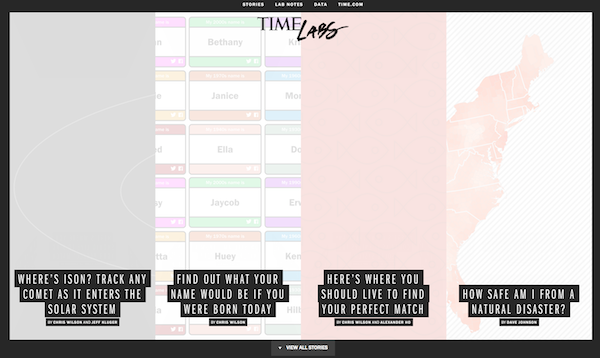‘Narcissism works really well’: Why Time magazine created a site for its interactive stories

News sites’ most popular digital offerings have been interactive games and quizzes, making them irresistible go-to formats for traffic-hungry publishers. Slate’s Travoltify name generator, which poked fun at John Travolta for botching Idina Menzel’s name at The Oscars this year, was the site’s most popular in its entire 18-year history. The New York Times’ dialect quiz was the most viewed for all of 2013. A 2014 quiz that let people see how much time they waste on Facebook got 4.7 million hits and gave Time its biggest traffic day ever, with 3.8 million uniques.
Now Time is hoping to exploit the formats’ popularity further by launching a standalone site, Time Labs, for its interactive stories. (The site is live after the launch was delayed for two days.) Time brought on Chris Wilson in 2013 to lead its interactive data team, and the stories his team has produced have been Time.com’s most popular for three years running. In 2013, for example, 5.6 million people read America’s Mood Map: An Interactive Guide to the United States of Attitude.
Traditional journalists can wring their hands, but the appeal of these stories is irrefutable. “We joke that narcissism works really well,” said Sam Jacobs, Time assistant managing editor, who recruited Wilson.

People don’t just click and share these stories; they spend time with them. Chartbeat found that 55 percent of readers spent fewer than 15 seconds actively on a page. Time said with many of its interactive stories, people are spending 70 seconds. “It’s the length of two commercials, but it’s an eternity on the Internet,” Jacobs said.
Creating a standalone home for Time’s interactive features makes sense for a few reasons. They’re visual in nature, so the new home will be a better canvas for them than the busily designed and fast-paced Time.com. (The interactive features will still appear on Time.com, though, for maximum exposure.) There won’t be any advertising on Time Labs to start, but most likely it will be limited to native-style ads that resemble the look and editorial style of the content.
Advertisers are gaining interest in how much time readers are spending on a site versus just clicks, and Time Labs also is a way for the publisher to capitalize on that interest. Buyers said more time spent can lead to a greater advertiser benefit, which in turn could help a site command higher ad rates, or at least more advertising.
“We’re certainly seeing an evolving sales narrative that contextualizes attention, engagement and time spent beyond monthly unique figures,” said Maikel O’Hanlon, vp of social media strategy at Horizon Media. “It shouldn’t be too hard for publishers to produce studies that identify a stronger advertiser benefit around content that keeps consumers’ attention longer. And with those studies in play, a more premium rate card would understandably follow.” There are no industry standards for buying this way, though, so putting value on the longer time spent is the hard part, said Jon Anselmo, director of digital innovation at MediaVest.
The question for traditional news sites is how far can they go with games and quizzes without watering down their journalistic mission. Some might question where that mission is with some of Time’s interactive stories, like this a cappella name generator it created for the release of the movie “Pitch Perfect 2.”
Wilson said Time’s interactive features will occasionally be pop culture-related, but they’ll be sophisticated and data-driven, citing Time managing editor Nancy Gibbs’ standard that the site be “nutritious.” “It’s not going to be our bread and butter, but it’s a way we can delight and entertain people using the skills we developed that we think are unique,” he said. To underscore that point, Time Labs is making the raw data and code behind its stories available to readers, to appeal to the most tech-savvy among them.
“It’s not just that these gimmicks work,” Jacobs said. “They’re all grounded in data; they’re all grounded in real information.”
Image courtesy of Time magazine.
More in Media

Here are the biggest misconceptions about AI content scraping
An increase in bots scraping content from publishers’ sites represents a huge threat to their businesses. But scraping for AI training and scraping for real-time outputs present different challenges and opportunities.

How Future is using its own AI engine to turn deeper engagement into ad dollars
Future is betting on AI to boost recirculation – and make that stickier audience more appealing to advertisers.

Substack’s video bet could be a growth hack for small creators
Video is helping smaller creators on Substack grow their subscriber numbers faster — but larger creators aren’t experiencing the same boost.





